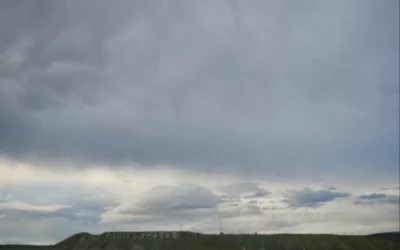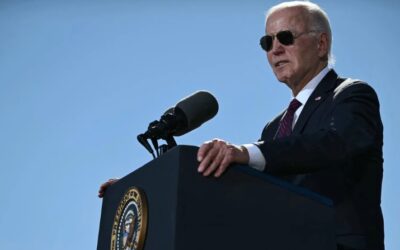Make our newscast part of your daily listening routine. Subscribe on Spotify (or wherever you listen to podcasts).
More than 200 items recently made their way back to the Northern Arapaho Tribe. Toys, beaded moccasins and traditional dresses received a motorcycle and police escort on part of their journey from Casper to the Wind River Reservation for the “Coming Home – Noe’heeckoohut Hiisi’” celebration. They were held by the Episcopal Church for the past 80 years.
On Indigenous People’s Day, car after car pulled into a dusty parking lot at St. Michael’s Mission in Ethete. People of all ages made their way to a courtyard known as “The Circle,” with old log and stone buildings around its edge. The crowd settled into folding chairs as Northern Arapaho tribal member Jordan Dresser stepped up to the mic.
“People always ask, how do tribes get back their items? And that’s a very complicated process,” he said.

The crowd listens as elders share their stories about St. Michael’s Mission and the Edith May Adams collection. (Hannah Habermann / Wyoming Public Media)
“The individual who collected the items was named Edith May Adams. Over time, she just bought these items and she just left them to the church itself,” continued Dresser.
Adams was a deaconess at St. Michael’s Mission from 1938 to 1946, who ran a small market and traded goods for Native-made items. Her collection was later moved to Laramie, then Casper.
Dresser and other tribal members have tried to get the items back to the reservation for decades. Some of the most recent efforts, documented in the film “What Was Ours”, focused on creating a small museum in the Wind River Hotel and Casino.
The church had loaned a slice of the items back to the tribe, but now, the whole collection is back for good.

Northern Arapaho elder Marian Scott shares about her time at the boarding school at St. Michael’s. (Hannah Habermann / Wyoming Public Media)
“The big question is ‘What happens to these items? What do we do with them all?’ I think it’s the site for a museum,” said Dresser.
He, along with other community members, would like to transform the century-old mission and its now unused boarding school buildings into something vibrant and thriving, for present and future generations.
At the boarding school at St. Michael’s in Ethete, students like Northern Arapaho elder Leona Buckman were separated from their language and culture.
“That’s the dorm that I was put in when I was a little girl in first grade. The first thing they did was cut our hair. We had long hair,” she said.

Northern Arapaho elder Leona Buckman speaks at the Coming Home celebration, with Northern Arapaho Business Council Chairman Lloyd Goggles (left) and Northern Arapaho Business Councilman Keenan Groesbeck (right). (Hannah Habermann / Wyoming Public Media)
From the early 1800s through as late as the 1970s, the federal government and religious institutions established boarding schools throughout the country, which sought to assimilate Indigenous youth into White culture.
That erasure went far beyond the schools and included the Religion Crimes Code of 1883. The law passed by Congress banned all Native dancing and ceremonies and was only officially reversed by the American Indian Religious Freedom Act in 1978.
“We’d have our sun dances and our ceremonies, but we’d have to hide. Our people would have to hide to have a ceremony,” said Buckman.
Northern Arapaho elder William C’Hair emphasized that those policies were part of a much bigger plan, succinctly summarized by Carlisle Boarding School founder Richard H. Pratt: “Kill the Indian in him, and save the man.”
“The federal government would subsidize missionaries if they [would] go on to reservations, establish missions to Christianize and de-Indianize the Indian,” said C’Hair.
But despite all that?
“They were unsuccessful to this day,” he said. “Not one Indian has ever turned white.”
Marian Scott, who turned 80 the day before the homecoming ceremony, was also a student at St. Michael’s. The Northern Arapaho elder went to Casper earlier in the year to see the items in the Edith May Adams collection, which was in storage at the church’s diocesan office.

Northern Arapaho elder William C’Hair delivers an opening prayer at St. Michael’s Mission in Ethete. (Hannah Habermann / Wyoming Public Media)
“Every time we opened a box and we seen those things that were in there, I could actually feel those people who they belonged to. And it was very, very emotional,” said Scott.
She said having the items finally returned was also very emotional.
“They’re here now. They’re back home,” said Scott.
The items were legally signed back to the tribe at the end of the ceremony.
Afterward, Northern Arapaho Tribal Historic Preservation Office Director Crystal C’Bearing said she thought she would never see this day.
“Honestly, you know, there’s been attempts in the past and they were always told no,” she said.
The church’s most recent bishop didn’t want to give back the items, but he was removed last year due to Title IV charges. The church is now being run by a standing committee, which was asked to return the items by a recently formed equity task force.
The committee ended up having a different opinion than the bishop.
“They said, ‘We should just give them back, they’re yours.’ That just made me so happy and excited”, said C’Bearing. “I was just ready for those words.”

President of the Episcoal Church in Wyoming’s Standing Committee Reverend Megan Nickles officially transfers the Edith May Adams collection back to the Northern Arapaho Tribe. (Hannah Habermann / Wyoming Public Media)
Reverend Mary Erickson is an associate rector at the St. John’s Episcopal Church in Jackson. She’s been part of the effort to return the items and said the day had been full of emotions.
“Joyful, joyful. And some sadness that it took us this long,” she said.
Church leaders apologized to the tribe during a service in Casper the night before the homecoming. Clergy members also delivered a liturgy of lament and healing before the items were officially transferred back to the tribe.
“I think it is the beginning, just the very beginning of some healing in the relationship between the Episcopal Church of Wyoming and the Arapaho people, and that’s a good thing,” said Erickson.
According to Erickson, the Episcopal Church still owns about a hundred acres of land nearby. She said that could be the next thing to return.
“Might be harder, I don’t know, or maybe not. Maybe now we’ve broken through, we can get that done more quickly, but I think that’s an important conversation to have,” she said.

Our Father’s House Church at St. Michael’s Mission in Ethete. (Hannah Habermann / Wyoming Public Media)
Reverend Roxanne Friday is the Indigenous Minister for the Episcopal Church in Wyoming and has been part of the repatriation process for nearly 40 years. She’s Eastern Shoshone and Seneca from the Seneca Nation of Indians in New York and said today was watching history in the making.
“I wish that there were people here that have gone now that could have shared this day with us, but they knew it was coming,” she said.
Friday is the priest in charge for St. David’s in Fort Washakie as well as Our Father’s House, a church on the west side of “The Circle” that still holds services.
“One of the things I want to get done before I go from this earth is that this circle is revitalized, with youth and things that we can do to help in the healing of generational trauma and all the things that we’ve dealt with in our lives,” said Friday.

Children play on a playground after the ceremony next to what was once a museum at St. Michael’s Mission. (Hannah Habermann / Wyoming Public Media)
The next step is to renovate one of the buildings in the Mission into a museum. Once that’s up and running, the plan is to create a permanent home for the items and open it up to the community.
On Oct. 25, Pres. Joe Biden formally apologized to Native Americans for the government’s boarding school system during a visit to the Gila River Indian Community in Arizona.
He said the schools will “always be a significant mark of shame, a blot on American history.” It was Biden’s first official visit to an Indigenous community as president and was the first public apology about federal boarding school policy from a sitting U.S. president.





